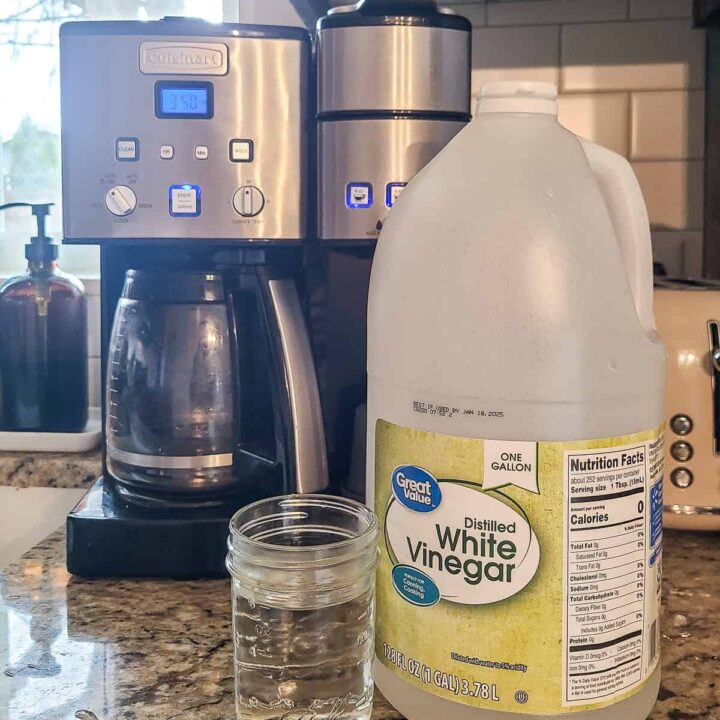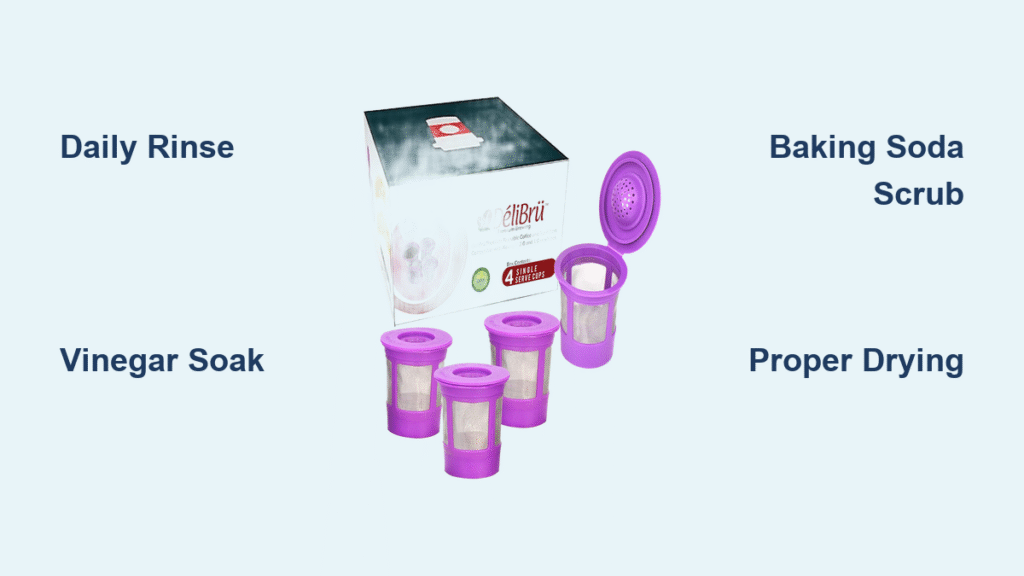That bitter, stale coffee taste isn’t always about the beans—it’s often your neglected reusable K-Cup filter cup. Months of accumulated coffee oils, mineral deposits, and trapped grounds create rancid residues that sabotage flavor and clog your Keurig. Left uncleaned, this buildup shortens your filter cup’s lifespan and risks mold growth. You don’t need expensive replacements when proper cleaning restores peak performance. This guide delivers battle-tested methods to eliminate stubborn gunk and make every brew taste fresh again—starting with the critical 45-second habit you’re probably skipping right now.
Daily Rinse After Brewing
Skipping this immediate post-brew step guarantees hardened residue that requires aggressive scrubbing later. Remove your reusable K-Cup within 60 seconds while components are still warm—this prevents coffee oils from solidifying into concrete-like deposits inside the mesh filter. Hold the filter cup under warm running water (100-120°F) for 30-45 seconds, rotating constantly to blast grounds from every perforation. Use your fingertips to gently dislodge particles clinging to the mesh interior, then shake vigorously to expel trapped water. This simple ritual dissolves fresh oils before they polymerize, cutting deep cleaning time by 70%. Never use hot water—it warps plastic housings and damages fine mesh filters over time. If your coffee tastes metallic or bitter within days of cleaning, you’ve likely skipped this foundational step.
Why Warm Water Beats Cold for Oil Removal
Coffee oils behave like cooking grease—they liquefy when warm but solidify when cooled. Warm water (not hot) emulsifies these oils instantly, while cold water merely spreads them. Test this yourself: drop coffee oil into warm vs. cold water. The warm sample disperses immediately; the cold version forms stubborn globules. This scientific principle is why your daily rinse must use water between 100-120°F. Keep a dedicated pitcher of warm tap water by your Keurig to make this effortless.
Weekly Deep Cleaning Methods

Vinegar Solution Soak for Oil Breakdown
When daily rinses aren’t enough, vinegar’s acetic acid dissolves months of baked-on coffee oils without harsh chemicals. Mix equal parts white vinegar and warm water (½ cup each) in a small container. Fully disassemble your K-Cup—remove the mesh filter, lid, and rubber seal—then submerge all parts for 30 minutes minimum. Every 10 minutes, agitate the solution by swirling components with tongs to dislodge stubborn residue. After soaking, rinse under warm running water for 2-3 minutes until the vinegar smell vanishes completely. If odor persists, soak components in fresh water for 10 additional minutes. Critical warning: Vinegar residue leaves acidic coffee—rinse until water runs odorless.
Baking Soda Scrub for Stain Removal
For brownish stains that vinegar can’t penetrate, baking soda’s mild abrasiveness lifts discoloration without scratching. Create a paste with 2 tablespoons baking soda and 1 tablespoon water (toothpaste consistency). Apply it to all interior surfaces using your fingertip, focusing on stained mesh areas. Let it sit 15-20 minutes—this dwell time allows the paste to break down tannins. Gently scrub in circular motions with a soft-bristled brush (a baby toothbrush works perfectly), then rinse until water runs clear. Hold the mesh filter against a bright light post-rinse; any visible residue means repeating the process. This method safely removes “coffee tannin” stains that mimic rust.
Dishwasher Cleaning Rules

Top-Rack Only Placement Protocol
Only attempt dishwasher cleaning if your K-Cup explicitly states “dishwasher safe” on its base or packaging. Place components on the top rack—never the bottom—to avoid direct exposure to heating elements that warp plastic at 130°F+. Secure the mesh filter between silverware tines to prevent tumbling, and disable the heated dry cycle to prevent steam damage. Run a normal wash cycle, then immediately inspect for lingering residue. If grounds remain trapped in crevices, hand-washing is mandatory. Red flag: Warped plastic or loose mesh after washing means your K-Cup is permanently damaged—hand-wash all future cleanings.
Monthly Inspection and Storage

Mesh Filter Integrity Test
Every 2-4 weeks, perform this 60-second check: Hold the mesh filter against a bright window or phone flashlight. Any visible holes, stretched fibers, or light leaks mean grounds will contaminate your brew. Simultaneously inspect plastic components for stress cracks (white hairline fractures) and rubber seals for brittleness. If coffee appears gritty despite proper filling, replace the filter immediately—no cleaning can fix physical damage. Quality reusable K-Cups last 1-2 years with this vigilance; ignoring wear guarantees bitter, sediment-filled coffee.
Proper Drying and Storage Technique
Air-dry all components for 2-4 hours in a well-ventilated area with the cup opening facing downward—this gravity drainage prevents water pooling in the base. Use a paper towel to wick moisture from the rubber seal groove, a common mold breeding ground. Store only when bone-dry in a cool, dark place (not under the sink!). Humidity near your dishwasher or stove invites mold, so choose a high cabinet. Never seal damp components in plastic containers—breathable mesh bags are ideal. This protocol prevents 95% of mold issues reported by Keurig users.
Fix Persistent Filter Problems
Eliminate Rancid Coffee Odors
Old coffee oils turn rancid within days, creating sour smells that transfer to fresh brews. For stubborn odors, extend your vinegar soak to 2-4 hours instead of 30 minutes. Alternatively, fill the dry K-Cup with baking soda, seal it in a ziplock bag, and leave overnight—baking soda absorbs volatile compounds. Sunlight exposure for 2-3 hours also neutralizes odors via UV oxidation. Test success by sniffing the dry filter; any coffee scent means repeating the process. Never brew with odor-retaining cups—those rancid compounds ruin flavor chemistry.
Mold Emergency Protocol
Visible mold requires immediate action: discard the K-Cup—no cleaning eliminates spores. To prevent recurrence, always ensure 100% dryness before storage and increase deep cleaning to twice weekly in humid climates. Never leave used filters soaking overnight; mold spores colonize in 24 hours. If you detect musty smells during brewing, run three water-only cycles through your Keurig to flush the system before replacing the filter cup.
Optimize Brewing Performance
Three Lifespan-Extending Habits
- Rotate multiple K-Cups: Use 2-3 cups interchangeably to guarantee 24+ hours of drying time between brews
- Use filtered water: Reduces mineral deposits that clog mesh filters by 60%
- Never overfill: Level, not heaping, coffee grounds prevent pressure damage to mesh
Aggressive scrubbing during cleaning is the #1 cause of premature filter failure—treat the mesh like fine silk. Replace when cleaning no longer restores smooth water flow or flavor clarity. Most users extend filter life to 18+ months with these practices versus 6 months with neglect.
Your morning coffee’s quality hinges on this truth: a clean reusable K-Cup filter cup is non-negotiable. Implement the 45-second daily rinse immediately—this single habit prevents 80% of deep cleaning needs. Schedule weekly vinegar soaks every Sunday morning while your first brew steeps, and inspect your mesh filter monthly during grocery runs. Within one week of consistent care, you’ll taste brighter acidity, richer body, and none of that stale bitterness. Don’t wait for mold or clogs to force action; your freshest cup starts with the filter cup in your hand right now. Grab that warm water pitcher and rinse—your future self will savor the difference before breakfast ends.





